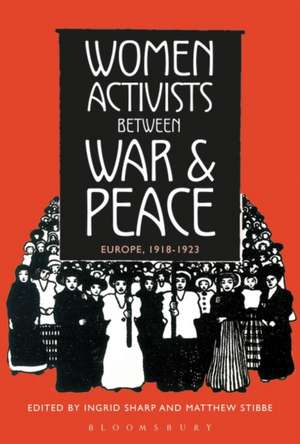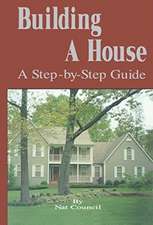Women Activists between War and Peace: Europe, 1918-1923
Editat de Professor Ingrid Sharp, Professor Matthew Stibbeen Limba Engleză Paperback – 31 oct 2018
| Toate formatele și edițiile | Preț | Express |
|---|---|---|
| Paperback (1) | 238.67 lei 6-8 săpt. | |
| Bloomsbury Publishing – 31 oct 2018 | 238.67 lei 6-8 săpt. | |
| Hardback (1) | 774.62 lei 6-8 săpt. | |
| Bloomsbury Publishing – 3 mai 2017 | 774.62 lei 6-8 săpt. |
Preț: 238.67 lei
Nou
Puncte Express: 358
Preț estimativ în valută:
45.67€ • 47.40$ • 38.18£
45.67€ • 47.40$ • 38.18£
Carte tipărită la comandă
Livrare economică 17-31 martie
Preluare comenzi: 021 569.72.76
Specificații
ISBN-13: 9781472578778
ISBN-10: 1472578775
Pagini: 288
Ilustrații: 19 bw illus
Dimensiuni: 156 x 234 x 22 mm
Greutate: 0.41 kg
Ediția:NIPPOD
Editura: Bloomsbury Publishing
Colecția Bloomsbury Academic
Locul publicării:London, United Kingdom
ISBN-10: 1472578775
Pagini: 288
Ilustrații: 19 bw illus
Dimensiuni: 156 x 234 x 22 mm
Greutate: 0.41 kg
Ediția:NIPPOD
Editura: Bloomsbury Publishing
Colecția Bloomsbury Academic
Locul publicării:London, United Kingdom
Caracteristici
Experienced contributors from the UK, the USA, Canada and Bulgaria offer a comparative, transnational approach to the subject
Notă biografică
Ingrid Sharp is Senior Lecturer in German at the University of Leeds, UK. She is the editor of Aftermaths of War (co-edited with Matthew Stibbe, 2011) and The Women's Movement in Wartime (co-edited with Alison Fell, 2007).Matthew Stibbe is Professor of Modern European History at Sheffield Hallam University, UK. He has authored several books and edited several volumes of essays on twentieth-century European themes, including Aftermaths of War (co-edited with Ingrid Sharp, 2011).
Cuprins
List of Illustrations Notes on ContributorsAcknowledgements List of Abbreviations Time-Line: Women Activists between War and Peace, 1918-1923 Introduction: Women Activists between War and Peace: Europe, 1918-1923Ingrid Sharp and Matthew Stibbe 1. Suffrage and Nationalism in Comparative Perspective: Britain, Hungary, Finland and the Transnational Experience of Rosika SchwimmerLead authors: Julie V. Gottlieb and Judith Szapor, with Tiina Lintunen (on Finland) and Dagmar Wernitznig (on Rosika Schwimmer) 2. Internationalism, Pacifism, Transnationalism: Women's Movements and the Building of a Sustainable Peace in the Post-War WorldLead author: Ingrid Sharp, with Judit Acsády (on Hungary) and Nikolai Vukov (on Bulgaria) 3. Women and Socialist Revolution, 1917-1923 Lead author: Matthew Stibbe (on Germany), with Olga Shnyrova (on Russia) and Veronika Helfert (on Austria) 4. Mediating the National and the International: Women, Journalism and Hungary in the Aftermath of the First World WarLead authors: Maria DiCenzo, Judit Acsády, David Hudson and Balázs Sipos 5. Women's Movements, War and the Body Lead authors: Alison S. Fell and Susan R. Grayzel Further Reading
Recenzii
This collection of essays opens a new window onto women's activism in post-WWI Europe by reaching beyond the boundaries of Western Europe to include the voices of women from Eastern Europe and the Scandinavian region. The essays included number only five, but they are a rich collaboration between and among scholars from a variety of historic fields. The contributors have mined new sources to analyze the roles of women activists in journalism, political movements, the pacifist movement, and women's citizenship rights; specifically, a woman's right to vote as well as her relationship with her own body as the physical and psychological traumas of war encroached on and forever modified understandings of "male" and "female." Consequently, these essay masterfully weave together women's postwar activism by viewing the sources through various lenses in order to examine the ways in which activism belied national boundaries and brought women together from disparate social, cultural, and geographic places to work toward a shared goal. Summing Up: Highly recommended. Upper-division undergraduates and above.
A must-read on the significance of the women activists at local, national and supranational settings in the immediate aftermath of the First World War. It is equally illuminating on gender relations and men's attempts to stifle or support these women. The volume achieves something rare: the co-authorship offers geographical and thematic range but not at the expense of coherence, neither within nor between chapters. The result is moving, shocking and inspiring in equal measure.
This is a remarkable and innovative approach to comparative women's history. The multi-authored essays are particularly useful in helping us to analyse women's post-war activism not only by considering the impact of internationalism versus particular national settings in a truly transnational perspective, but also by questioning paradigms of European women's history through case studies of Eastern Europe, particularly Hungary .
This collection of long multi-authored and multinational articles speaks to a perceived need for a closer look at what women activists of all political persuasions were up to in the turbulent years immediately following World War I. Comparative, in-depth analyses provide special insight into developments in the traumatized new nations (especially Hungary) that emerged from the former multi-ethnic empires of Germany, Austria-Hungary, and Russia. The women activists discussed in this volume ranged from feminists, pacifists, and socialists to nationalists, conservative Catholics, and proto-fascists; some became journalists, other politicians. Obtaining the vote for women did not mean that women's activism was henceforth unilaterally feminist; rather, it was fragment, multi-directional, continually constrained (but also provoked in some cases) by the political turmoil and geopolitical transitions that accompanied the reorganization of a war-torn Europe. I wish I had access to these thoughtful and beautifully-documented studies twenty years ago when I was writing European Feminism, 1700-1950.
This valuable collection of comparative, multi-authored essays demonstrates vividly how our understanding of European history can be enhanced, if not transformed, by investigating what women activists did and said, and how the relations of the sexes changed in consequence of the brutal war.
A must-read on the significance of the women activists at local, national and supranational settings in the immediate aftermath of the First World War. It is equally illuminating on gender relations and men's attempts to stifle or support these women. The volume achieves something rare: the co-authorship offers geographical and thematic range but not at the expense of coherence, neither within nor between chapters. The result is moving, shocking and inspiring in equal measure.
This is a remarkable and innovative approach to comparative women's history. The multi-authored essays are particularly useful in helping us to analyse women's post-war activism not only by considering the impact of internationalism versus particular national settings in a truly transnational perspective, but also by questioning paradigms of European women's history through case studies of Eastern Europe, particularly Hungary .
This collection of long multi-authored and multinational articles speaks to a perceived need for a closer look at what women activists of all political persuasions were up to in the turbulent years immediately following World War I. Comparative, in-depth analyses provide special insight into developments in the traumatized new nations (especially Hungary) that emerged from the former multi-ethnic empires of Germany, Austria-Hungary, and Russia. The women activists discussed in this volume ranged from feminists, pacifists, and socialists to nationalists, conservative Catholics, and proto-fascists; some became journalists, other politicians. Obtaining the vote for women did not mean that women's activism was henceforth unilaterally feminist; rather, it was fragment, multi-directional, continually constrained (but also provoked in some cases) by the political turmoil and geopolitical transitions that accompanied the reorganization of a war-torn Europe. I wish I had access to these thoughtful and beautifully-documented studies twenty years ago when I was writing European Feminism, 1700-1950.
This valuable collection of comparative, multi-authored essays demonstrates vividly how our understanding of European history can be enhanced, if not transformed, by investigating what women activists did and said, and how the relations of the sexes changed in consequence of the brutal war.











